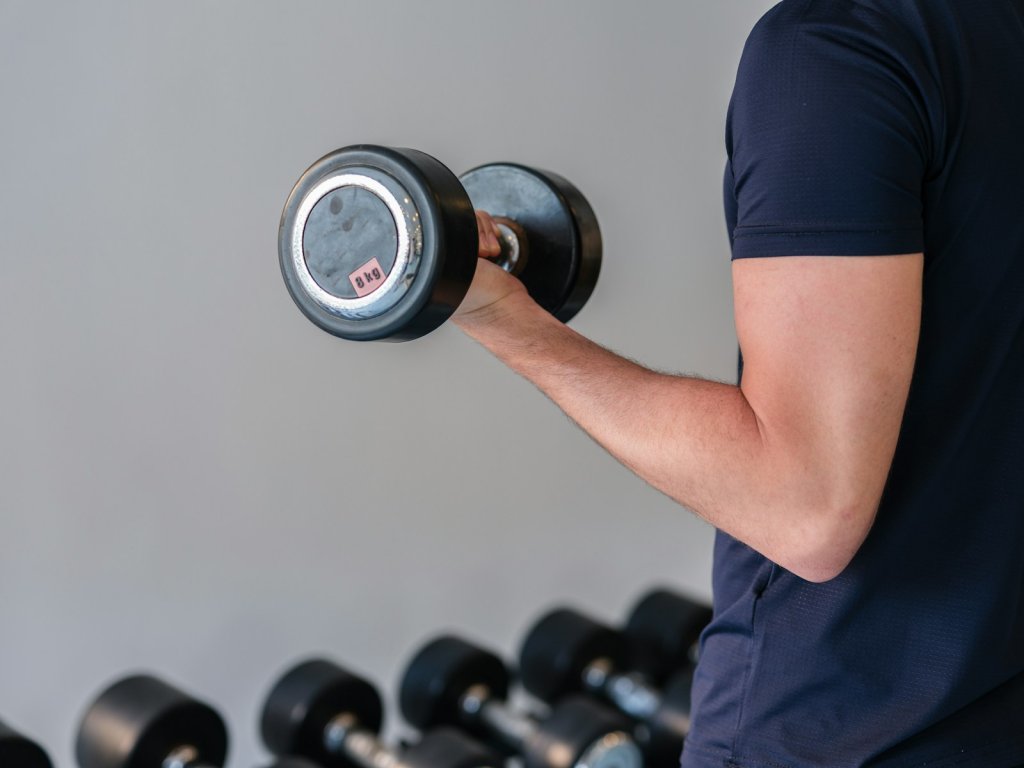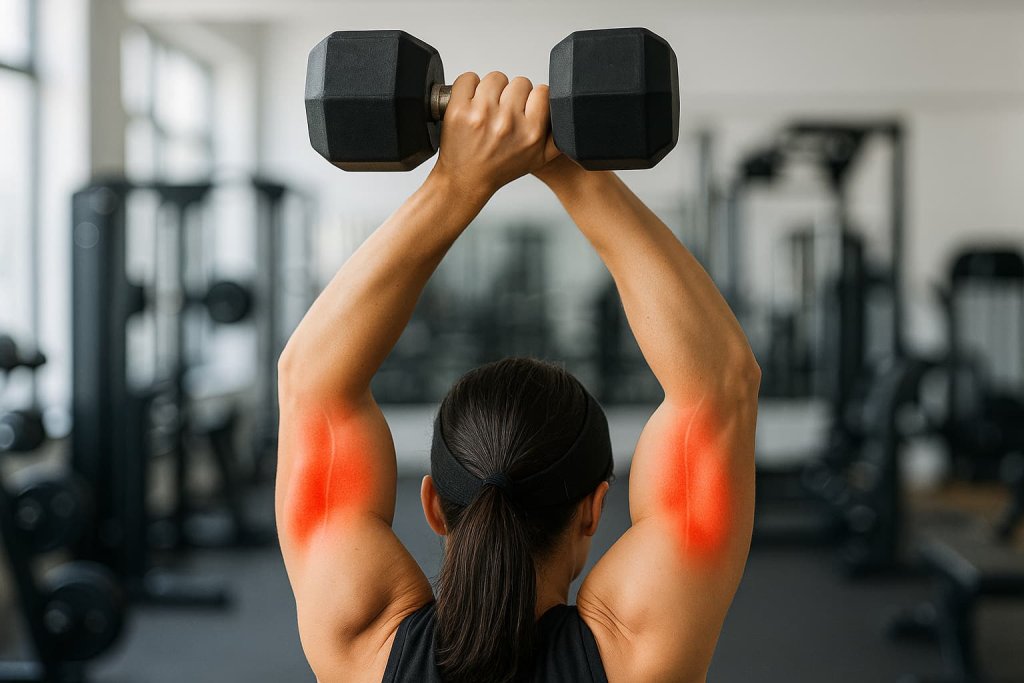The best dumbbell triceps exercises for mass and shape are proven by science and trainers to maximize arm growth, strength, and definition. Whether you’re training at home or at the gym, these moves target all three triceps heads, leading to bigger arms and balanced muscle development.

Dumbbells are a must for serious lifters—they allow freedom of movement, better joint health, and perfectly target each arm for symmetry and shape.
Understanding which exercises work best and how to program them will help you avoid wasted effort and see results faster. This guide covers every aspect you need—technique, programming, science, and troubleshooting.
For the latest research-backed training recommendations, check the ACE Triceps Exercise Library.
Why Dumbbell Triceps Training Matters

The Case for Dumbbells
- Maximized Muscle Activation: Research confirms that dumbbell triceps exercises recruit all three heads—the long, lateral, and medial triceps—often more completely than fixed-bar moves (ACE, 2024). This means more potential for growth, shape, and definition.
- Balanced Arm Development: Dumbbells force each arm to work independently, reducing muscle imbalances and helping you achieve symmetrical, athletic arms.
- Joint-Friendly and Safe: Dumbbell triceps work allows your wrists, elbows, and shoulders to move more naturally. This reduces strain, especially for lifters with prior joint discomfort.
- Home and Gym Friendly: All you need is a set of dumbbells and a bench or chair—making these exercises accessible for anyone, anywhere.
Trainer Insight:
“If you want to fill out your sleeves, prioritize dumbbell triceps extensions and presses. The freedom of movement protects your joints while maximizing muscle tension.”
15 Best Dumbbell Triceps Exercises (With Variations)
1. Close-Grip Dumbbell Bench Press
How to Do It:
Lie flat on a bench holding two dumbbells above your chest, palms facing each other. Lower the weights slowly, keeping elbows tucked close to your torso, until your arms form a 90-degree angle. Press the dumbbells back up, maintaining a slight squeeze inward.
Why It Works:
This move emphasizes the medial and lateral heads of the triceps, allowing you to handle heavier loads safely. It mimics the classic close-grip barbell press but with more freedom for wrist and shoulder comfort.
Trainer Tip:
Squeeze the dumbbells together gently as you press up—this creates extra inner triceps tension and boosts muscle engagement.
2. Seated or Standing Overhead Dumbbell Extension
How to Do It:
Sit or stand holding a dumbbell (or two) overhead with both hands. Lower the weight behind your head, keeping elbows pointed up. Extend arms fully at the top.
Why It Works:
This position stretches and targets the long head of the triceps—crucial for building the horseshoe shape.
Science Note:
Overhead angles have been shown to maximize triceps activation compared to other movements.
Options:
Try with a single arm for more core challenge and to address muscle imbalances.
3. Lying Dumbbell Triceps Extension (Skull Crusher)
How to Do It:
Lie on a bench, arms extended above your chest holding dumbbells. Lower them toward your forehead (or behind the head for extra stretch), then extend back up.
Why It Works:
Hits all three triceps heads. Using dumbbells provides a neutral grip, making it easier on wrists and elbows compared to a barbell.
Variation:
Do on a slight incline to increase stretch, especially for the long head.
4. Incline Dumbbell Skull Crusher
How to Do It:
Set a bench to a 30–45° incline. Lie back, holding dumbbells above you. Lower them behind your head, then extend arms.
Why It Works:
The incline provides a deeper stretch for the long head, improving muscle length and growth potential.
Trainer Tip:
Lock your upper arms in place—don’t let elbows drift.
5. Dumbbell Kickback (Flat or Incline)
How to Do It:
With knee and hand on a bench (or lying chest-down on an incline), keep your upper arm parallel to your torso. Extend the dumbbell back and up, pausing at the top.
Why It Works:
One of the highest EMG-activating exercises for the lateral triceps head—perfect for shaping and defining the arm’s outer portion (ACE Fitness, 2023).
Trainer Tip:
Pause for a second at peak contraction for maximal muscle recruitment.
6. Dumbbell JM Press
How to Do It:
Lie on a bench, hold dumbbells above the chest. Lower weights toward the forehead at a 45-degree angle, then press up.
Why It Works:
Combines the mechanics of a close-grip press and a triceps extension, blending strength and hypertrophy stimulus.
Advanced Option:
Use a palms-in (neutral) grip to shift stress slightly.
7. Single-Arm Overhead Dumbbell Extension
How to Do It:
Sit or stand, holding a dumbbell overhead in one hand. Lower the dumbbell behind your head, then press back up.
Why It Works:
Fixes imbalances and allows you to hone mind-muscle connection.
Trainer Tip:
Support your working arm’s elbow with your free hand for strict, safe form.
8. Dumbbell Floor Press (Close-Grip)
How to Do It:
Lie on the floor, press dumbbells above your chest with elbows tucked in. Lower until triceps touch the floor, then press up.
Why It Works:
Reduces shoulder strain, limits range for safer heavy pressing. Great for building lockout strength.
Tip:
Ideal when you lack a bench or want to avoid shoulder irritation.
9. Rolling Triceps Extension
How to Do It:
Start with dumbbells held above your chest. Lower them toward your forehead, then “roll” (bring) weights to your upper chest and press up in one smooth movement.
Why It Works:
Adds continuous tension and a greater stretch at the bottom—promoting more muscle growth.
Trainer Tip:
Keep elbows pointed forward—don’t flare them.
10. Dumbbell Triceps Kickback with Twist
How to Do It:
Perform a kickback, but as you reach the top, twist your wrist so your palm faces up.
Why It Works:
Boosts contraction and lateral head recruitment. The twist increases the time under tension and triceps activation.
11. Incline One-Arm Dumbbell Skull Crusher
How to Do It:
Lie sideways or on an incline bench, perform a single-arm skull crusher.
Why It Works:
Allows a greater range of motion and unilateral focus—perfect for correcting size or strength imbalances.
Trainer Tip:
Move slowly and control the dumbbell throughout the entire range.
12. Dumbbell Tate Press
How to Do It:
Lie on a bench, hold dumbbells over your chest with elbows flared out. Lower dumbbells toward the mid-chest, then press back up.
Why It Works:
Targets the inner triceps, helping to develop the central portion and improve pressing lockout.
Trainer Tip:
Start with lighter weights; the angle stresses elbows more than standard presses.
13. Neutral-Grip Dumbbell Floor Press
How to Do It:
Perform a floor press but with palms facing each other (neutral grip).
Why It Works:
Minimizes wrist strain and targets the triceps through a safer range of motion. Useful for those with shoulder or wrist discomfort.
14. Dumbbell Crush Press
How to Do It:
Hold two dumbbells together over your chest. Squeeze them together throughout the movement as you press up and lower down.
Why It Works:
Maximizes inner triceps tension, especially at the top (lockout) of the press. Excellent for the “finishing” pump.
15. Dumbbell Diamond Push-Up (Hands on Dumbbells)
How to Do It:
Place two dumbbells close together on the floor, grip them so hands form a diamond shape, and perform a push-up.
Why It Works:
Ultra-high triceps activation. Using dumbbells keeps wrists in a neutral position, making the movement more comfortable and safer.
Trainer Tip:
If too challenging, drop to your knees or reduce range until strength improves.
Science, Safety, and Programming Tips
- Frequency: Train triceps 2–3 times per week for optimal results (NSCA, 2023).
- Reps and Sets: Use 8–15 reps for size, 4–8 for strength, and higher (15–25) for endurance.
- Warm Up: Always warm up elbows and shoulders before heavy pressing or extensions.
- Balance: Combine different angles—overhead, press, and kickback—for complete triceps growth.
Common Mistakes to Avoid
- Using excessive weight and sacrificing form
- Flaring elbows outward (increases injury risk)
- Not fully extending or contracting the triceps at each rep
- Ignoring unilateral (single-arm) exercises—leads to imbalances
Sample Dumbbell Triceps Workout Plan for Mass & Shape
Do this workout 1–2 times per week, spaced out for full recovery.
| Exercise | Sets | Reps | Rest | Focus |
|---|---|---|---|---|
| Close-Grip Dumbbell Bench Press | 3 | 8–10 | 60 sec | Heavy compound |
| Seated Overhead Dumbbell Extension | 3 | 10–12 | 60 sec | Long head stretch |
| Dumbbell Kickback (Incline) | 3 | 12–15 | 45 sec | Isolation/high rep |
| Incline Dumbbell Skull Crusher | 3 | 8–10 | 60 sec | Stretch, full activation |
| Rolling Triceps Extension | 2 | 10–12 | 60 sec | Eccentric focus |
- Warm Up: Start with 5 minutes of arm circles, light push-ups, and easy triceps stretches.
- Progression: Increase weight or reps each week as form allows.
- Weekly Volume: For best results, aim for 10–20 sets per week targeting triceps (Stronger By Science, 2024).
Key Tips for Massive Gains and Joint Health
- Warm Up Thoroughly: Protect elbows and shoulders with light sets and mobility drills.
- Perfect Your Form: Full range of motion and slow negatives maximize muscle growth.
- Don’t Rush: Controlled reps ensure tension stays on the triceps, not momentum.
- Vary Your Grip: Switch between neutral, supinated, and pronated grips to fully engage all triceps heads.
- Mind-Muscle Connection: Visualize squeezing the triceps, especially at the top of each rep.
Science & Trainer Insights
- Why All Three Heads Matter: The triceps make up two-thirds of your upper arm size. Training each head (long, lateral, medial) ensures balanced, aesthetic growth and superior strength for pressing.
- EMG Evidence: Studies show that overhead and close-grip presses recruit the long head most, while kickbacks and extensions recruit lateral and medial heads. A mix is ideal (ACE, 2024).
- Dumbbells vs Barbells: Dumbbells offer a safer range for wrists and elbows and are proven to match barbell strength gains for most lifters.
Frequently Asked Triceps Training Questions
Which triceps exercise gives the most mass?
The close-grip dumbbell bench press and overhead extensions are top choices, recruiting the most muscle fibers for growth.
How many times per week should I train triceps?
2 sessions per week, with at least 48 hours rest in between, gives optimal growth for most lifters.
What’s the best rep range?
Mix 8–10 reps (heavy) with 12–15 reps (moderate) for maximum muscle building.
Can you get great triceps with only dumbbells?
Absolutely! Scientific reviews show dumbbells provide full triceps activation and great results for size, strength, and shape.
Real-World Example Workout Split
Sample Push/Pull/Legs Routine Including Dumbbell Triceps:
- Day 1: Push (Chest, Shoulders, Triceps)
- Dumbbell Bench Press
- Overhead Dumbbell Triceps Extension
- Dumbbell Kickback
- Day 3: Pull (Back, Biceps)
- Day 5: Legs (Quads, Glutes, Hamstrings)
- Day 6: Arms (Biceps & Triceps Focus)
- Incline Dumbbell Skull Crusher
- Rolling Triceps Extension
- Dumbbell Tate Press
This rotation allows recovery and keeps triceps fresh for each session.
Conclusion
If you want bigger, stronger, and more defined arms, make these dumbbell triceps exercises the foundation of your workouts. They’re backed by the latest research and trusted by top trainers for a reason—they work! Mix heavy presses, overhead stretches, and isolation kickbacks for the best muscle-building results.
